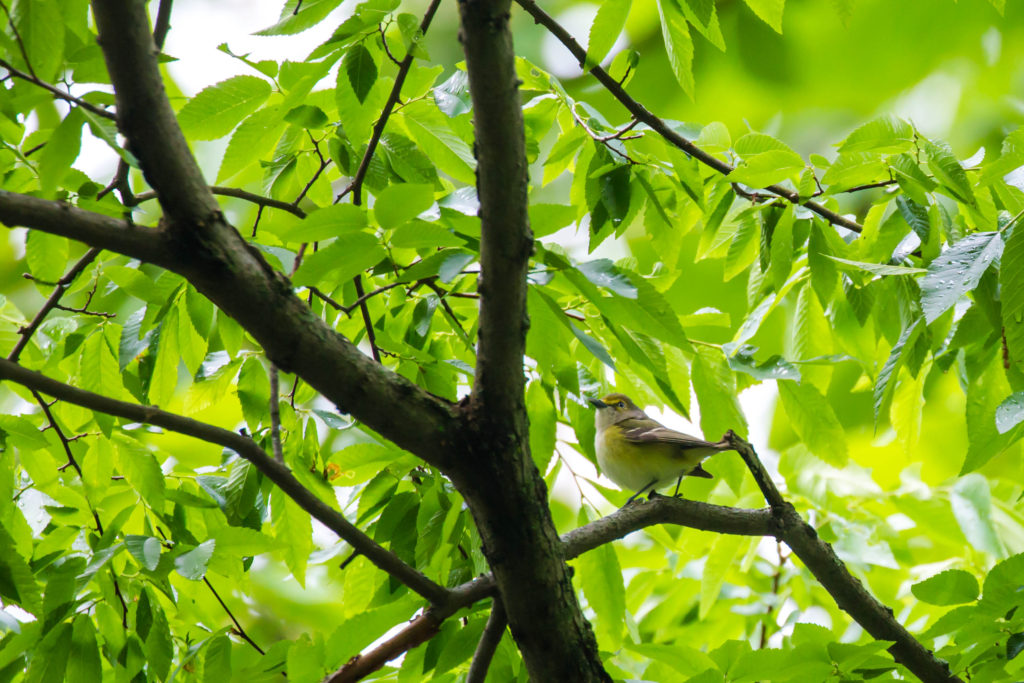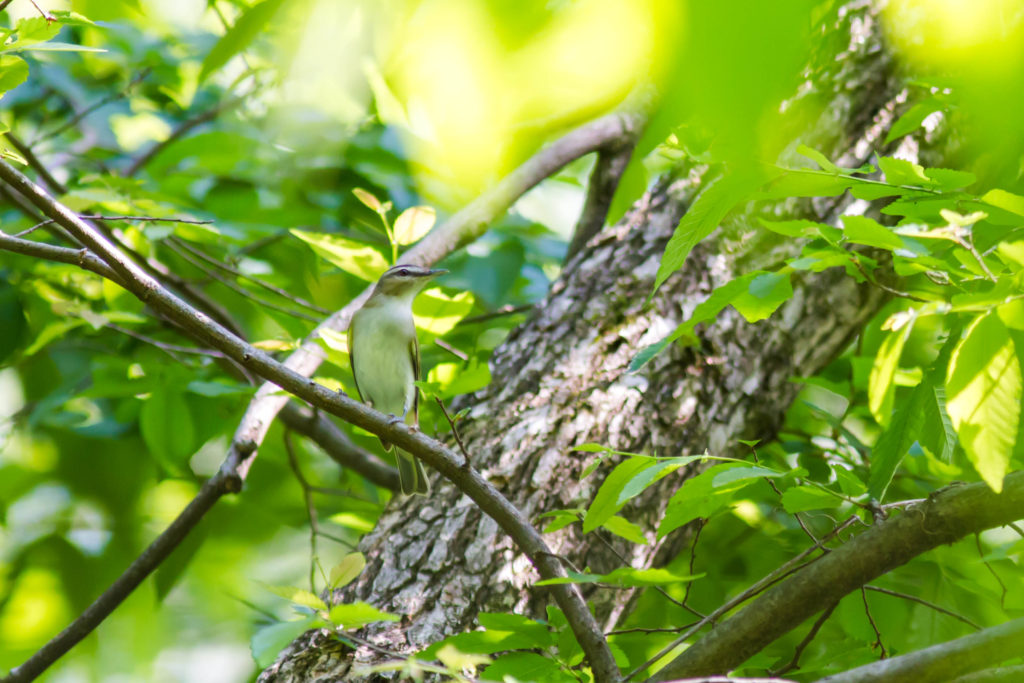Bucks for Birds #3: Heard But Not Seen
This has been the most challenging week yet of Bucks for Birds. For one thing, working to raise a million dollars in two months has confined most of my bird-spotting to my spare time! But when I do get out, I can hear so many birds as they return to the forest after a long absence: wood thrushes singing, great crested flycatchers yawping, hawks crying out overhead. Even the red-bellied woodpecker, who I probably photograph every single month in the woods, taunts me just out of sight.
This year’s early leaf-out meant that the trees had about a three-week head start in creating hiding places before the migratory birds arrived, and it’s making actual spotting difficult. I’ve been involved in a weeklong dance with a pileated woodpecker who won’t come higher than three feet off the ground, and has chosen the one part of the Old Forest Loop where there are no “spaghetti” trails that allow me to approach her from a different angle.
Going out almost every day in the spring means you get to experience each year’s “firsts” as they happen. So I was happy last week to hear a familiar chattering high overhead that meant the chimney swifts had returned. This is a bird I’ve never seen up-close, and I only know what its face looks like from photos taken by people who had better access or equipment than I do. I know them as the chatty little groups that swoop through the sky. For years, I actually thought they were bats because they move similarly, but then I realized they’re far too active in the daytime! Chimney swifts are so hard to photograph because they physically cannot perch, sit upright, or walk on the ground. Their tiny legs require vertical structures like chimneys or hollow trees to cling to and build their nests. This means they’re flying almost constantly, so if you hear high-pitched noises over your head as you take your walk, look up and watch their acrobatics.
Even though the chimney swift most closely resembles a swallow, its closest relative is actually the hummingbird. The ruby-throated hummingbirds are buzzing around the Old Forest this week, but they’ve mostly been on the move. This one perched pretty high over my head, at an angle where my choice was between a total silhouette or a shot through the leaves. Hummingbirds are so territorial that not only do they occupy the same patch of land over the course of a season (often making a particular tree their base of operations), many of them choose that same patch year after year. Their internal GPS is so fine-tuned that they can migrate thousands of miles away and come back to find the same tree. If you want to hear a remarkable tale about this, check out this NPR story of a wildlife rehabilitator and artist who raised three orphaned hummingbirds. And then buy her books. She’s a fantastic storyteller.
Next up we have two members of the vireo genus, a group of small birds that are often fairly drab in appearance but with strong voices. The white-eyed vireo uses harsh, abrupt notes. The first time I heard it sing, I thought someone was playing a video game in the forest. Go listen to the song–I bet it sounds familiar.
The red-eyed vireo was once described to me as constantly asking itself questions and answering them. It sings two notes in what we might call up-speak, and then answers with two notes in down-speak. I would say that this week, if you discount the usual cardinals, robins, wrens, and sparrows, this is the bird that’s the most vocal in the forest. They almost never stop talking! Listen to the song here.
Speaking of noise, if you notice a persistent whistling in the background of your walk, you’re probably passing under a flock of cedar waxwings. They’re spending their time in the canopy of the tallest trees (especially tulip poplars) eating insects, but in winter you can see them much lower to the ground (here’s a shot from a pear tree in my front yard). Waxwings love to eat berries and may come to fruiting trees and bushes in your yard. In fact, they are the species that Bucks for Birds will most help: they eat nandina berries and can die from the toxicity. Overripe berries from any plant can actually intoxicate them!
While I was craning my neck to see red-eyed vireo, I stumbled onto a scruffy indigo bunting. I often see groups of buntings and goldfinches foraging for food on the fence at Overton Bark, where they’re a whole lot easier to get a good look at!
Yay for the yellow warblers! The first of these showy birds I’ve seen this season is the hooded warbler. It’s one of the easier warblers to see, because it prefers the understory rather than the canopy.
Finally, we have a couple of birds you’re most likely to see on the forest edge. Chipping sparrows are tiny little birds with a rusty stripe on top of their heads and a black stripe through their eyes. They’re usually seen in groups foraging on the ground for seeds.
European starlings are the first non-native bird we’ve covered in this project. They were introduced to America in 1890 when a businessman released several dozen into Central Park with the goal of establishing every species mentioned by Shakespeare in America. Since then, they’ve multiplied with a vengeance. They come together in large flocks (up to a million!) and can cause destruction through a variety of means, such as the spread of disease, eating entire crop fields, and even flying en masse into plane engines. It’s hard, then, to appreciate that they’re quirky birds with beautiful iridescent plumage and an ability to imitate songs and sounds. In their native Europe, it’s easier to see the good than the bad, but at 200 million birds in the U.S. and counting, here they mostly wreak havoc.
It’s not as lofty as our $1 million Greensward goal, but we would very much appreciate your contribution if you’re enjoying Bucks for Birds. Our operations don’t cease even though we’re in the middle of this campaign, and that means raising funds for those operations doesn’t cease either. Make a pledge today. Do it for the waxwings. 🙂
The list to date (29):
- American robin
- Barred owl
- Blue-gray gnatcatcher
- Blue jay
- Brown-headed cowbird
- Carolina chickadee
- Carolina wren
- Cedar waxwing
- Chimney swift
- Chipping sparrow
- Downy woodpecker
- European starling
- Hairy woodpecker
- Hermit thrush
- Hooded warbler
- Indigo bunting
- Myrtle warbler
- Northern cardinal
- Northern parula
- Orange-crowned warbler
- Palm warbler
- Pileated woodpecker
- Red-eyed vireo
- Ruby-crowned kinglet
- Ruby-throated hummingbird
- Tufted titmouse
- White-breasted nuthatch
- White-eyed vireo
- White-throated sparrow













